1995 CHEVROLET CORVETTE low oil pressure
[x] Cancel search: low oil pressurePage 123 of 386
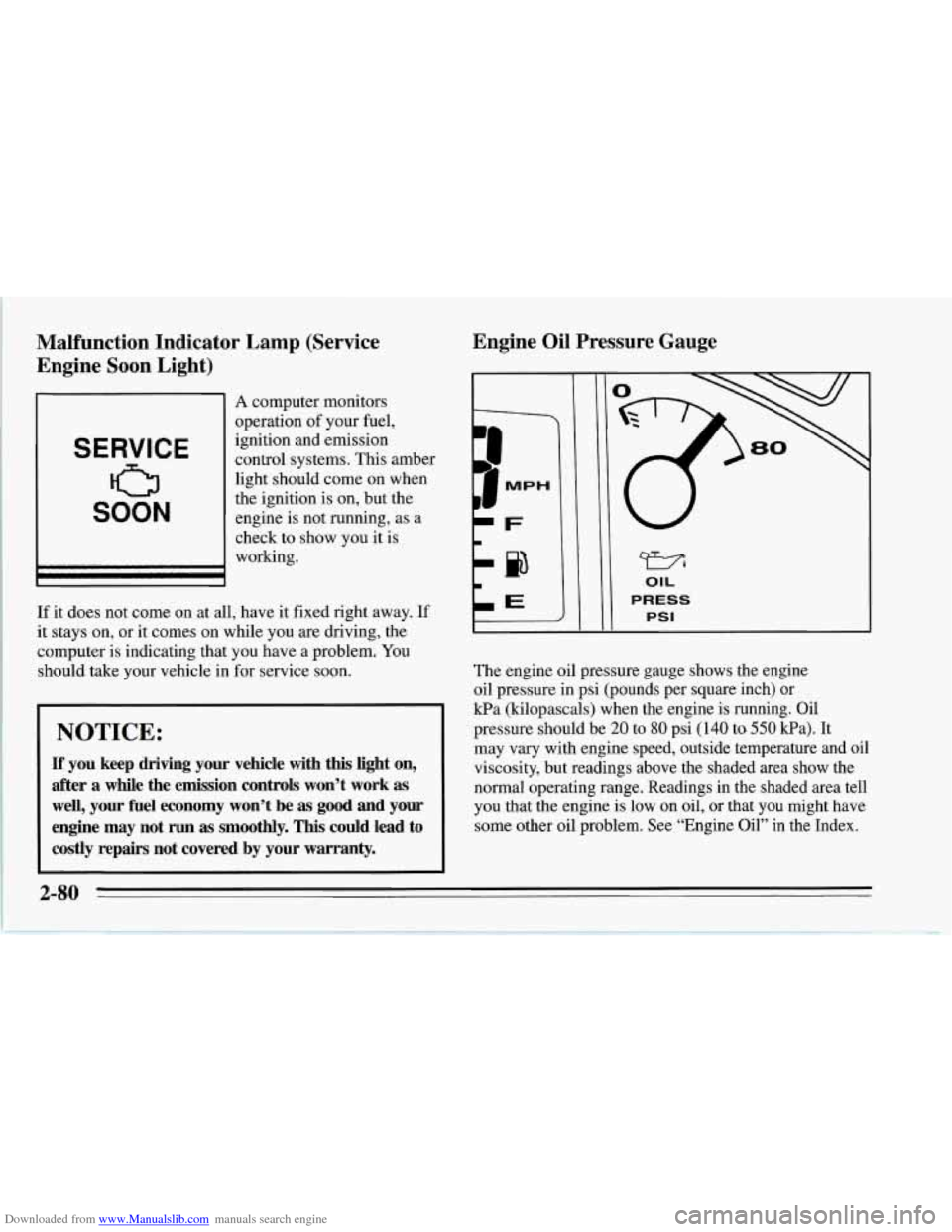
Downloaded from www.Manualslib.com manuals search engine Malfunction Indicator Lamp (Service
Engine Soon Light)
SERVICE
0
SOON
I
A computer monitors
operation
of your fuel,
ignition and emission
control systems. This amber
light should come on when
the ignition is on, but the
engine is not running, as a
check to show you it is
working.
If it does not come
on at all, have it fixed right away. If
it stays on, or it comes on while you are driving, the
computer is indicating that you have
a problem. You
should take your vehicle in for service soon.
NOTICE:
If you keep driving your vehicle with this light on,
after
a while the emission controls won’t work as
well, your fuel economy won’t be as good and your
engine may not
run as smoothly. This could lead to
costly repairs not covered by your warranty.
Engine Oil Pressure Gauge
-1
OIL
PRESS
PSI
The engine oil pressure gauge shows the engine
oil pressure in psi (pounds per square inch) or
kPa (kilopascals) when the engine is running. Oil
pressure should be
20 to 80 psi (140 to 550 Ea). It
may vary with engine speed, outside temperature and oil
viscosity, but readings above the shaded area show the
normal operating range. Readings in the shaded area tell
you that the engine is low on oil, or that you might have
some other oil problem. See “Engine Oil” in the Index.
2-80
Page 128 of 386
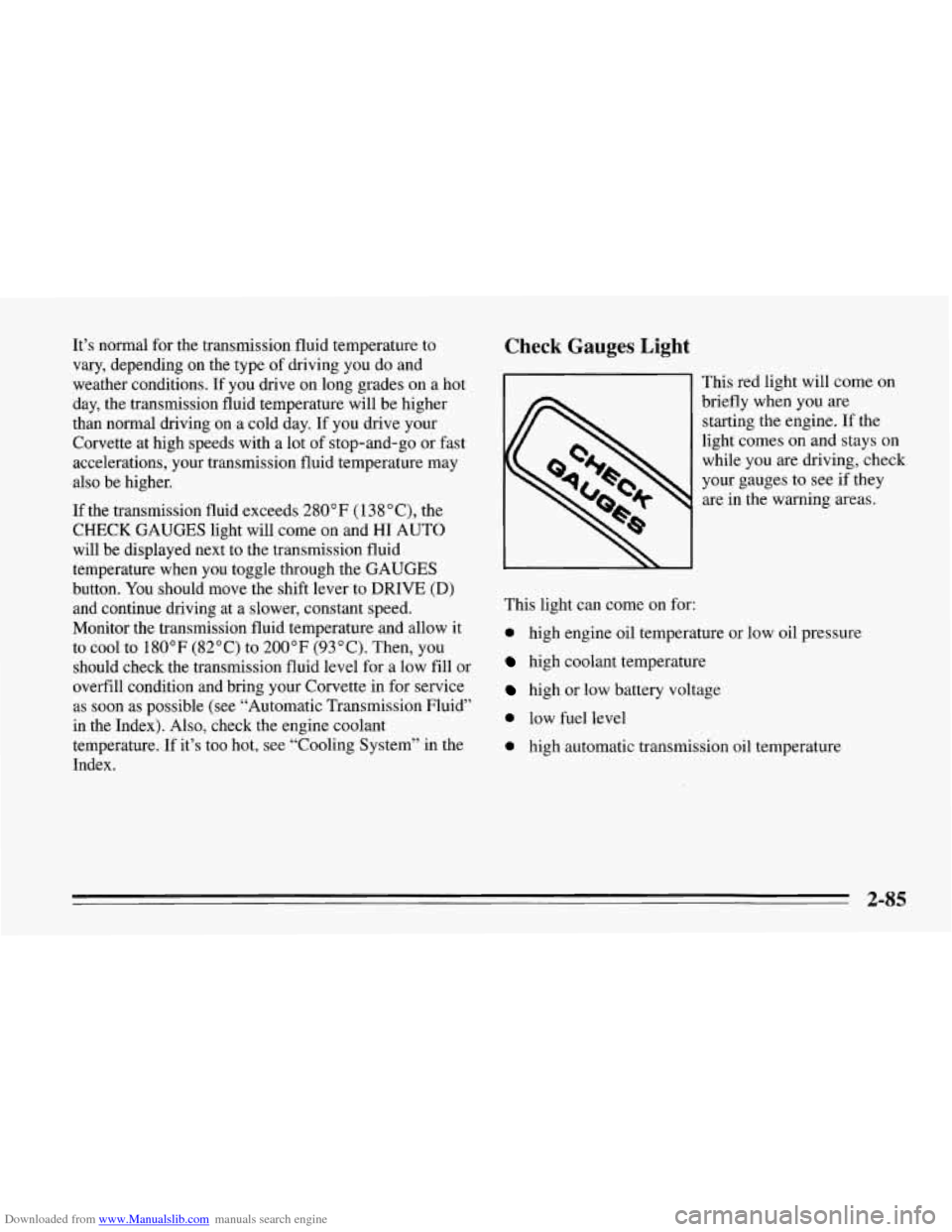
Downloaded from www.Manualslib.com manuals search engine It’s normal for the transmission fluid temperature to
vary, depending on the type of driving you do and
weather conditions. If you drive on long grades on a hot
day, the transmission fluid temperature will be higher
than normal driving on a cold day. If you drive your
Corvette at high speeds with a lot of stop-and-go or fast
accelerations, your transmission fluid temperature may
also be higher.
If the transmission fluid exceeds
280°F (138 “C), the
CHECK GAUGES light will come on and HI
AUTO
will be displayed next to the transmission fluid
temperature when you toggle through the GAUGES
button. You should move the shift lever to DRIVE (D)
and continue driving at a slower, constant speed.
Monitor the transmission fluid temperature and allow
it
to cool to 180°F (82°C) to 200°F (93°C). Then, you
should check the transmission fluid level for a low fill or
overfill condition and bring your Corvette in for service
as soon as possible (see “Automatic Transmission Fluid”
in the Index). Also, check the engine coolant
temperature. If it’s too hot, see “Cooling System” in the
Index.
Check Gauges Light
This red light will come on
briefly when you are
starting the engine. If the
light comes on and stays on
while
you are driving, check
your gauges to see if they
are
in the warning areas.
This light can come
on for:
0 high engine oil temperature or low oil pressure
high coolant temperature
high or low battery voltage
0 low fuel level
0 high automatic transmission oil temperature
2-85
Page 132 of 386
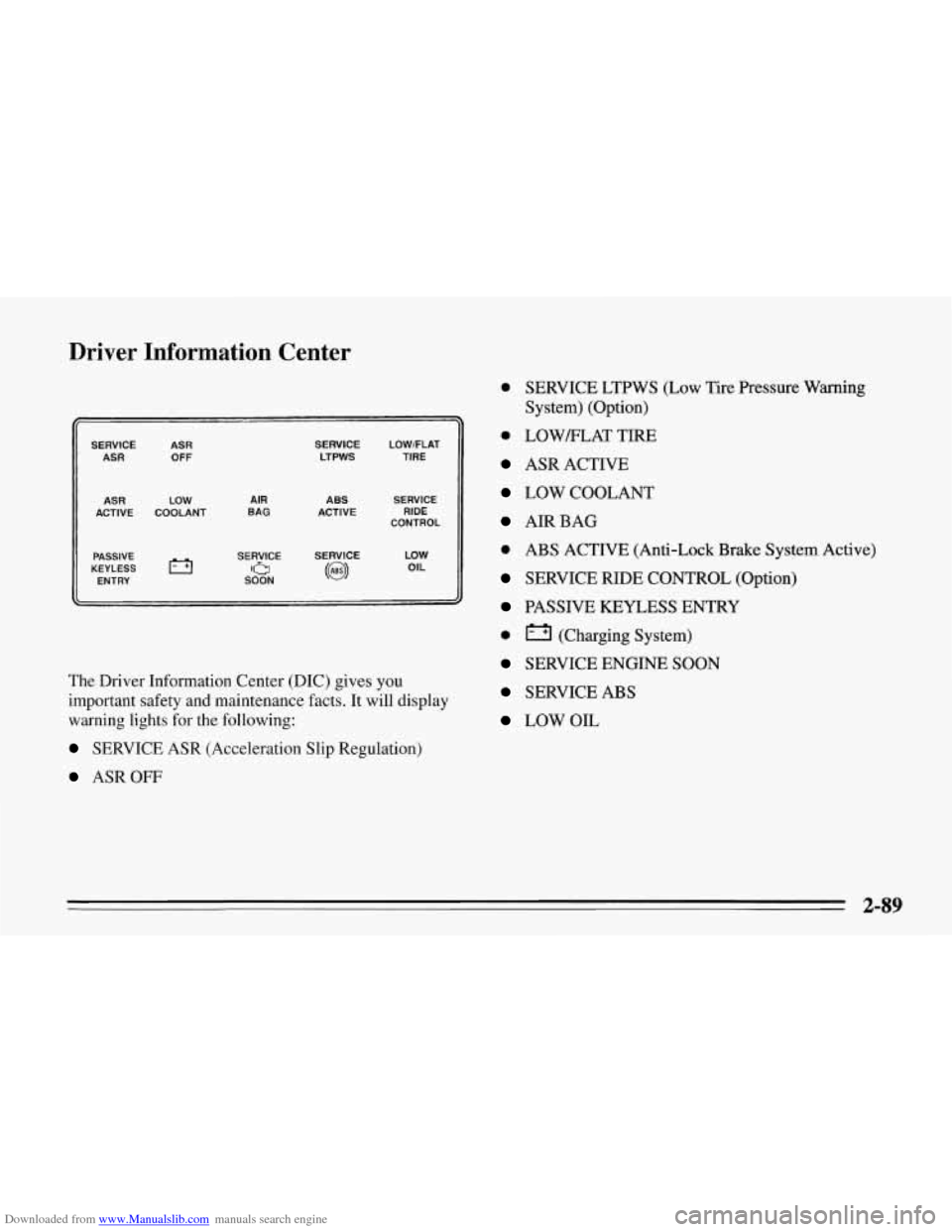
Downloaded from www.Manualslib.com manuals search engine Driver Information Center
SERVICE ASR ASR OFF
ASR LOW
ACTIVE COOLANT
PASSIVE
KEYLESS
ENTRY AIR
BAG
SERVICE
115- SOON
SERVICE LTPWS ABS
ACTIVE
SERVICE
(@I
LOWlFLAT TIRE
SERVICE RIDE
CONTROL
LOW OIL
The Driver Information Center (DIC) gives you
important safety and maintenance facts.
It will display
warning lights for the following:
SERVICE ASR (Acceleration Slip Regulation)
ASROFF
0 SERVICE LTPWS (Low Tire Pressure Warning
System) (Option)
0 LOWELAT TIRE
ASR ACTIVE
LOW COOLANT
AIRBAG
0 ABS ACTIVE (Anti-Lock Brake System Active)
SERVICE RIDE CONTROL (Option)
PASSIVE KEYLESS ENTRY
0 (Charging System)
SERVICE ENGINE SOON
SERVICE ABS
LOW OIL
2-89
Page 184 of 386
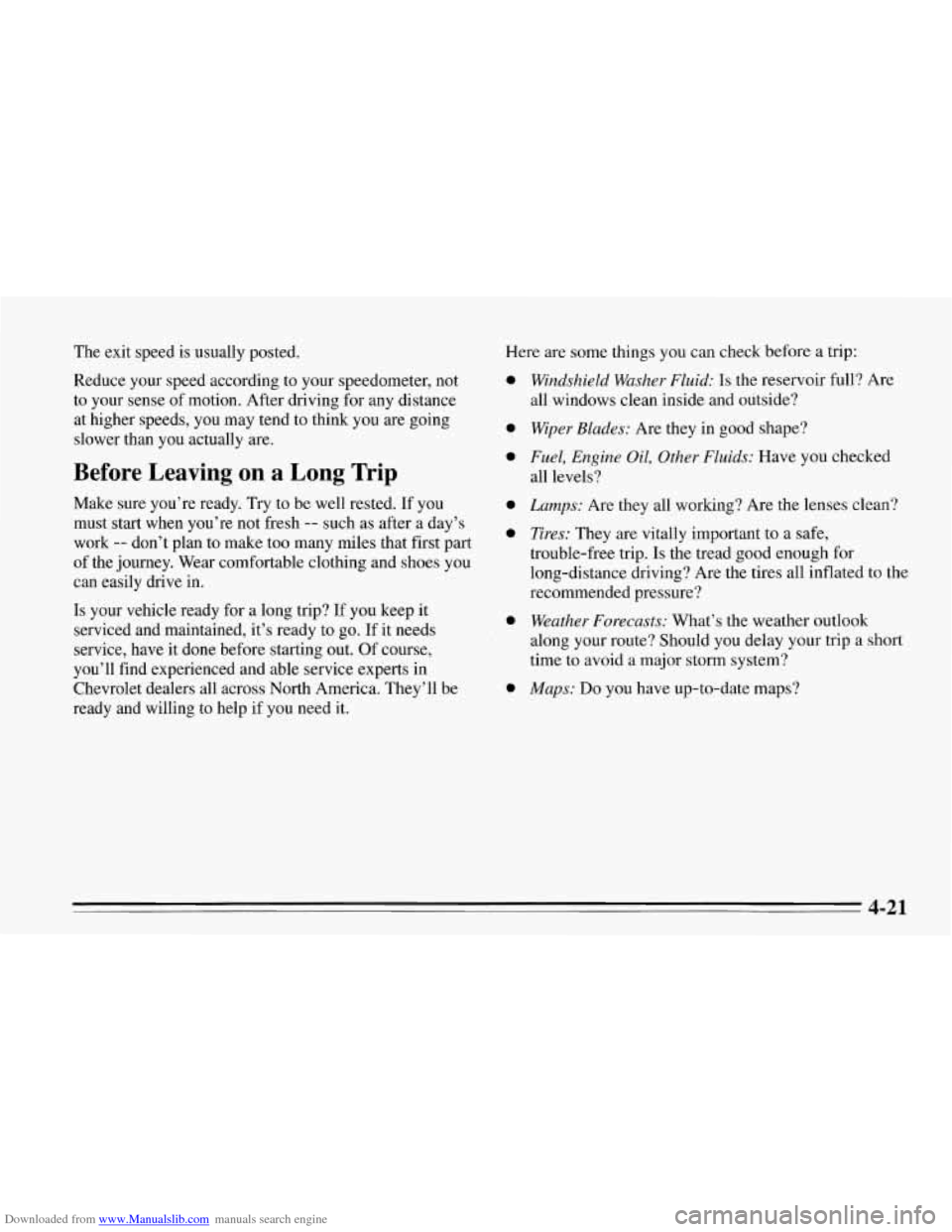
Downloaded from www.Manualslib.com manuals search engine The exit speed is usually posted.
Reduce your speed according to your speedometer, not
to your sense of motion. After driving for any distance
at higher speeds, you may tend to think
you are going
slower than you actually are.
Before Leaving on a Long Trip
Make sure you’re ready. Try to be well rested. If you
must start when you’re not fresh
-- such as after a day’s
work
-- don’t plan to make too many miles that first part
of the journey. Wear comfortable clothing and shoes you
can easily drive in.
Is your vehicle ready for a long trip?
If you keep it
serviced and maintained, it’s ready to
go. If it needs
service, have it done before starting out. Of course,
you’ll find experienced and able service experts in
Chevrolet dealers all across North America. They’ll be
ready and willing to help if you need it. Here
are some things you can check before a trip:
0
0
0
0
0
0
0
Windshield Washer Fluid: Is the reservoir full? Are
all windows clean inside and outside?
Wiper Blades: Are they in good shape?
Fuel, Engine Oil, Other Fluids: Have you checked
all levels?
Lamps: Are they all working? Are the lenses clean?
Tires: They are vitally important to a safe,
trouble-free trip. Is the tread good enough for
long-distance driving? Are the tires all inflated to the
recommended pressure?
Weather Forecasts: What’s the weather outlook
along your route? Should you delay your trip a short
time to avoid
a major storm system?
Maps: Do you have up-to-date maps?
4-21
Page 292 of 386
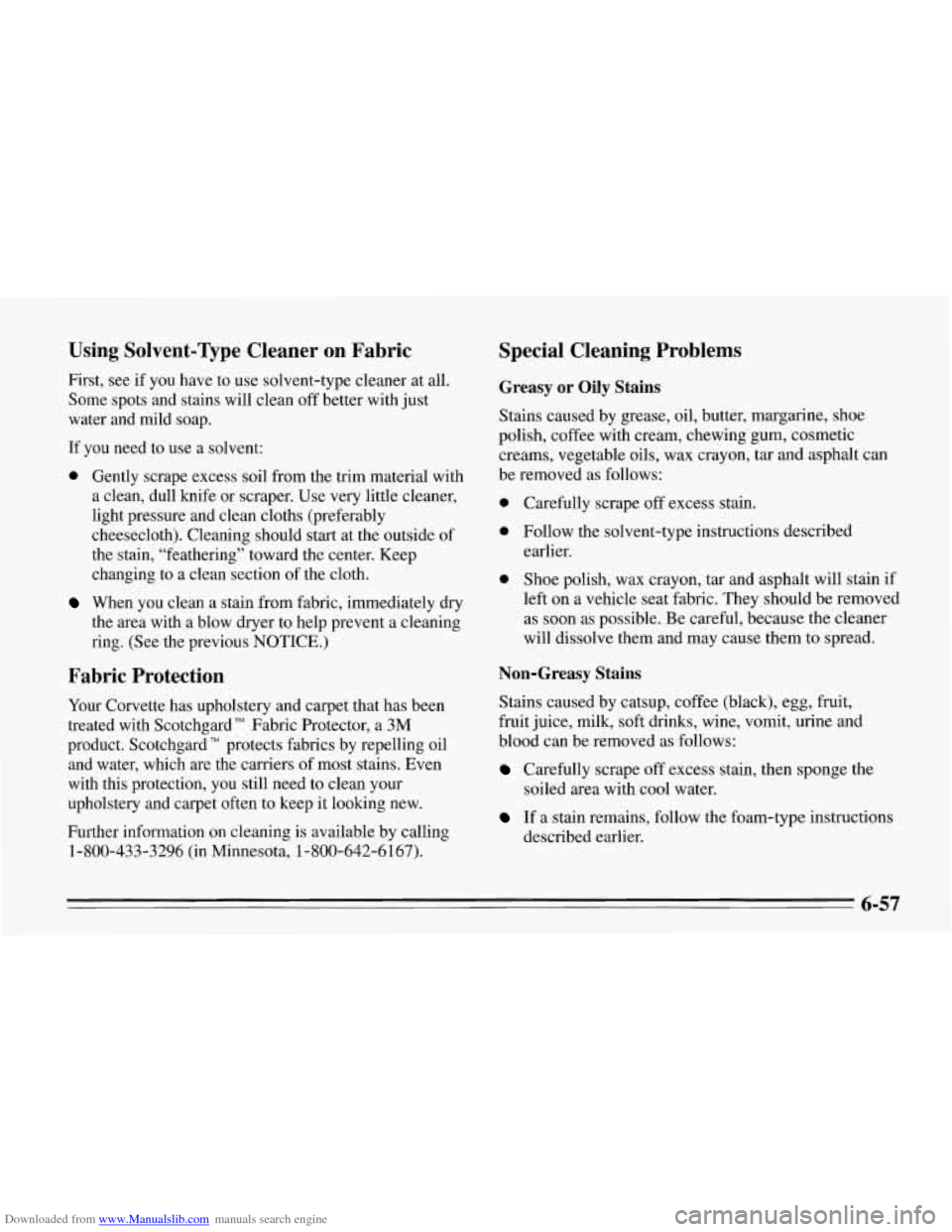
Downloaded from www.Manualslib.com manuals search engine Using Solvent-Type Cleaner on Fabric
First, see if you have to use solvent-type cleaner at all.
Some spots and stains will clean off better with just
water and mild soap.
If
you need to use a solvent:
0 Gently scrape excess soil from the trim material with
a clean, dull knife or scraper. Use very little cleaner,
light pressure and clean cloths (preferably
cheesecloth). Cleaning should start at the outside of
the stain, “feathering” toward the center. Keep
changing to a clean section of the cloth.
When you clean a stain from fabric, immediately dry
the area with a blow dryer to help prevent a cleaning
ring. (See the previous NOTICE.)
Fabric Protection
Your Corvette has upholstery and carpet that has been
treated with Scotchgard” Fabric Protector, a 3M
product. Scotchgard
TM protects fabrics by repelling oil
and water, which are the carriers of most stains. Even
with this protection, you still need to clean your
upholstery and carpet often to keep it looking new.
Further information on cleaning is available by calling
1-800-433-3296 (in Minnesota, 1-800-642-6167).
Special Cleaning Problems
Greasy or Oily Stains
Stains caused by grease, oil, butter, margarine, shoe
polish, coffee with cream, chewing gum, cosmetic
creams, vegetable oils, wax crayon, tar and asphalt can
be removed as follows:
a
0
0
Carefully scrape off excess stain.
Follow the solvent-type instructions described
earlier.
Shoe polish, wax crayon, tar and asphalt will stain
if
left on a vehicle seat fabric. They should be removed
as soon as possible. Be careful, because the cleaner
will dissolve them and may cause them to spread.
Non-Greasy Stains
Stains caused by catsup, coffee (black), egg, fruit,
fruit juice, milk, soft drinks, wine, vomit, urine and
blood can be removed as follows:
Carefully scrape off excess stain, then sponge the
soiled area with cool water.
If a stain remains, follow the foam-type instructions
described earlier.
6-57
Page 306 of 386
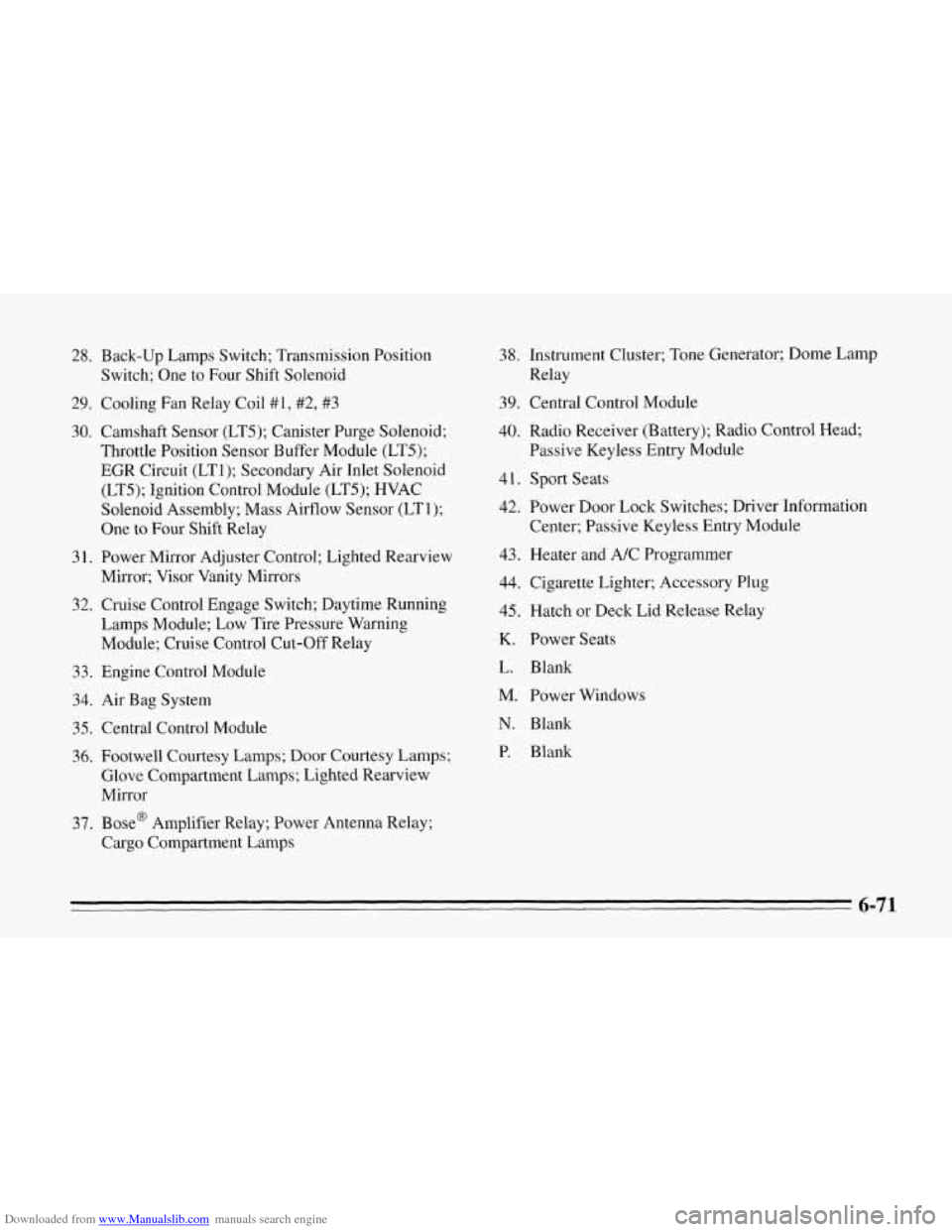
Downloaded from www.Manualslib.com manuals search engine 28. Back-up Lamps Switch; Transmission Position
Switch; One to Four Shift Solenoid
29. Cooling Fan Relay Coil
#I, #2, #3
30. Camshaft Sensor (LT5); Canister Purge Solenoid;
Throttle Position Sensor Buffer Module (LT5);
EGR Circuit (LT1); Secondary Air Inlet Solenoid
(LT5); Ignition Control Module (LT5); HVAC
Solenoid Assembly; Mass Airflow Sensor (LT 1);
One
to Four Shift Relay
3 1. Power Mirror Adjuster Control; Lighted Rearview
Mirror; Visor Vanity Mirrors
32. Cruise Control Engage Switch; Daytime Running
Lamps Module; Low Tire Pressure Warning
Module; Cruise Control Cut-Off Relay
33. Engine Control Module
34. Air Bag System
35. Central Control Module
36. Footwell Courtesy Lamps; Door Courtesy Lamps;
Glove Compartment Lamps; Lighted Rearview
Mirror
37, Bose@ Amplifier Relay; Power Antenna Relay;
Cargo Compartment Lamps
38. Instrument Cluster; Tone Generator; Dome Lamp
Relay
39. Central Control Module
40, Radio Receiver (Battery); Radio Control Head;
Passive Keyless Entry Module
41. Sport Seats
42. Power Door Lock Switches; Driver Information
Center; Passive Keyless Entry Module
43. Heater and A/C Programmer
44. Cigarette Lighter; Accessory Plug
45. Hatch or Deck Lid Release Relay
K. Power Seats
L. Blank
M. Power Windows
N. Blank
P. Blank
6-71
Page 356 of 386
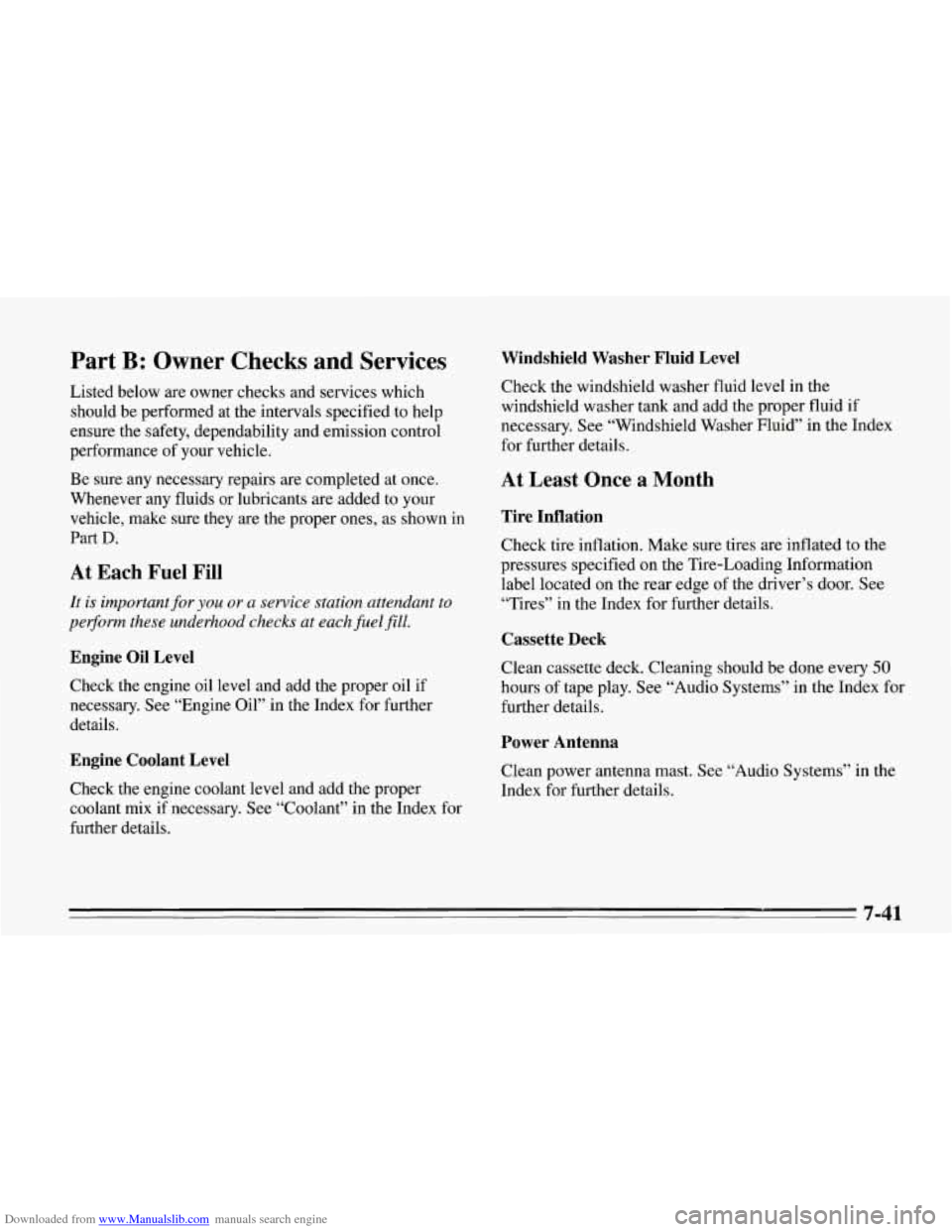
Downloaded from www.Manualslib.com manuals search engine Part B: Owner Checks and Services
Listed below are owner checks and services which
should be performed at the intervals specified to help
ensure the safety, dependability and emission control
performance of your vehicle.
Be sure any necessary repairs are completed at once.
Whenever any fluids or lubricants are added to your
vehicle, make sure they are the proper ones, as shown
in
Part D.
At Each Fuel Fill
It is important for you or a service station attendant to
per$orm these underhood checks at each fuel fill.
Engine Oil Level
Check the engine oil level and add the proper oil if
necessary. See “Engine Oil” in the Index for further
details.
Engine Coolant Level
Check the engine coolant level and add the proper
coolant mix
if necessary. See “Coolant” in the Index for
further details.
Windshield Washer Fluid Level
Check the windshield washer fluid level in the
windshield washer tank and add the proper fluid if
necessary. See “Windshield Washer Fluid” in the Index
for further details.
At Least Once a Month
Tire Inflation
Check tire inflation. Make sure tires are inflated to the
pressures specified on the Tire-Loading Information
label located on the rear edge of the driver’s door. See
“Tires”
in the Index for further details.
Cassette Deck
Clean cassette deck. Cleaning should be done every 50
hours of tape play. See “Audio Systems” in the Index for
further details.
Power Antenna
Clean power antenna mast. See “Audio Systems” in the
Index for further details.
7-41
Page 378 of 386
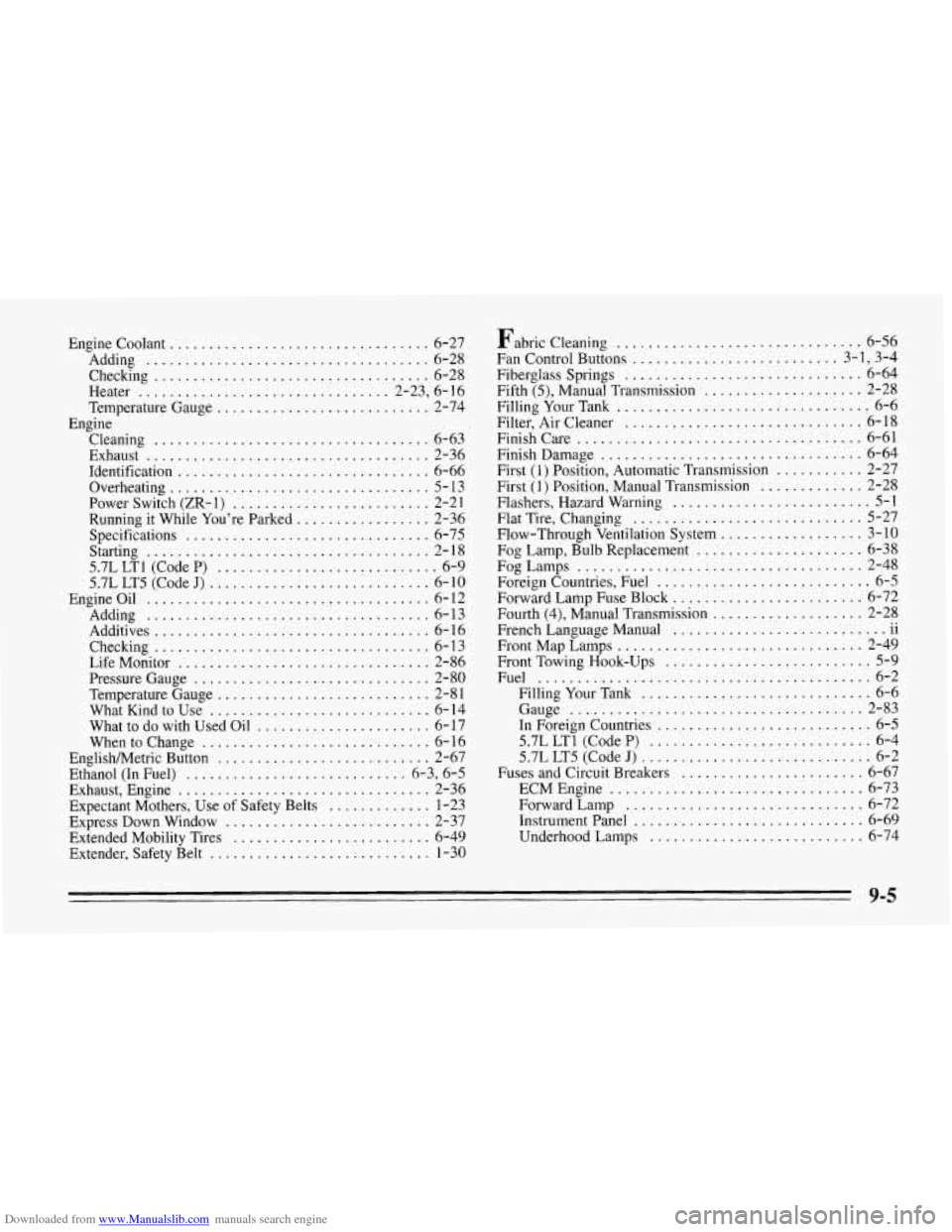
Downloaded from www.Manualslib.com manuals search engine Engine Coolant ................................. 6-27
Adding
.................................... 6-28
Checking
................................... 6-28
Heater
................................ 2-23, 6-16
Temperature Gauge
........................... 2-74
Engine
Cleaning
................................... 6-63
Exhaust
.................................... 2-36
Identification
................................ 6-66
Overheating
................................. 5-13
Power Switch (ZR-
1) ......................... 2-2 1
Running it While You’re Parked ................. 2-36
Specifications
............................... 6-75
5.7L LT1 (Code P) ............................ 6-9
5.7L LT5 (Code
J) ............................ 6- 10
Adding .................................... 6-13
Additives
................................... 6-16
Checking
................................... 6-13
Life Monitor
................................ 2-86
Pressure Gauge
.............................. 2-80
Temperature Gauge
........................... 2-8 1
What Kind to Use
............................ 6-14
What to do with Used Oil
...................... 6-17
When to Change
............................. 6- 16
EnglishMetric Button
........................... 2-67
Ethanol (In Fuel)
............................ 6-3, 6-5
Exhaust, Engine ................................ 2-36
Expectant Mothers, Use of Safety Belts
............. 1-23
Express Down Window
.......................... 2-37
Extended Mobility Tires
......................... 6-49
Extender, Safety Belt
............................ 1-30
Starting
.................................... 2-18
Engineoil
.................................... 6-12 Fabric
Cleaning
............................... 6-56
Fan Control Buttons
.......................... 3.1, 3.4
Fiberglass Springs
.............................. 6-64
Fifth (5). Manual Transmission
.................... 2-28
Filling Your Tank
................................ 6-6
Filter. Air Cleaner
.............................. 6-18
Finish Care
.................................... 6-61
Finish Damage
................................. 6-64
First
(1) Position. Manual Transmission ............. 2-28
Flashers. Hazard Warning
......................... 5-1
Flat Tire. Changing ............................. 5-27
Flow-Through Ventilation System
.................. 3-10
Fog Lamp. Bulb Replacement ..................... 6-38
Fog Lamps
.................................... 2-48
Foreign Countries. Fuel
........................... 6-5
Forward Lamp Fuse Block
........................ 6-72
Fourth (4). Manual Transmission
................... 2-28
French LanguageManual
........................... 11 ..
Front Map Lamps ............................... 2-49
Front Towing Hook-Ups
.......................... 5-9
Fuel
.......................................... 6-2
FillingYourTank
............................. 6-6
Gauge
..................................... 2-83
First (1) Position. Automatic Transmission
........... 2-27
In Foreign Countries
........................... 6-5
5.7L LTl (Code P)
............................ 6-4
5.7L LT5 (Code
J) ............................. 6-2
Fuses and Circuit Breakers
....................... 6-67
Forward Lamp
.............................. 6-72
Instrument Panel
............................. 6-69
Underhood Lamps
........................... 6-74
ECMEngine
................................ 6-73
9-5